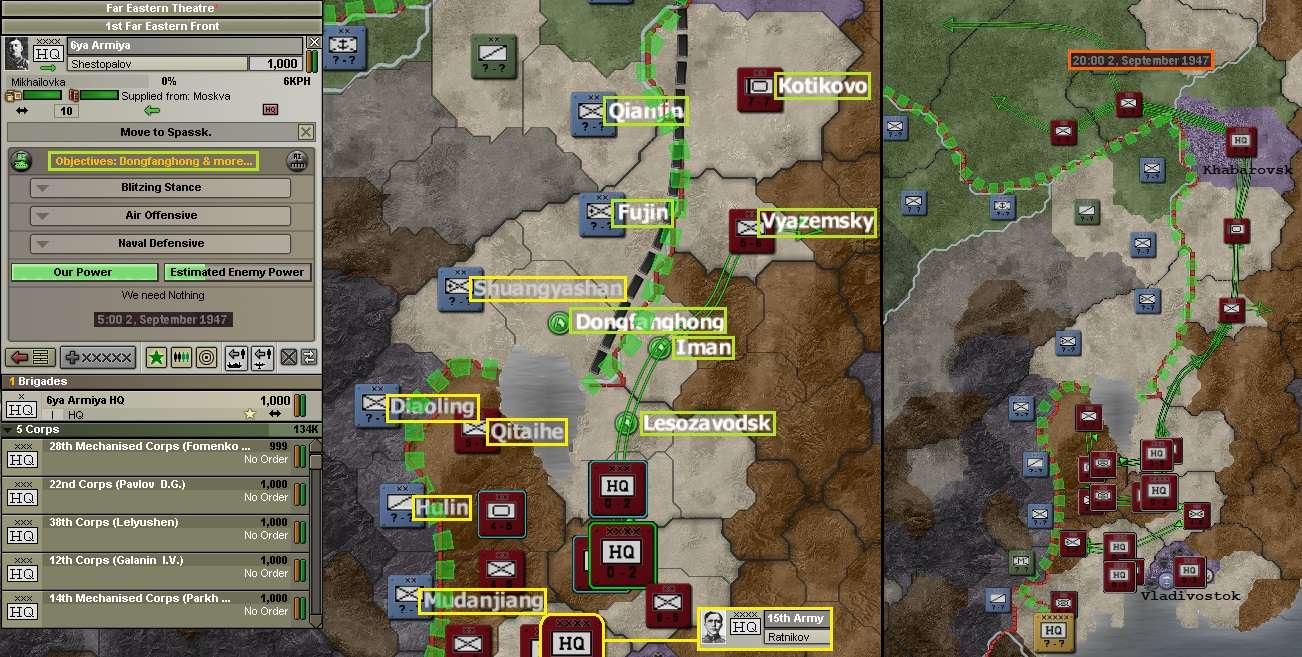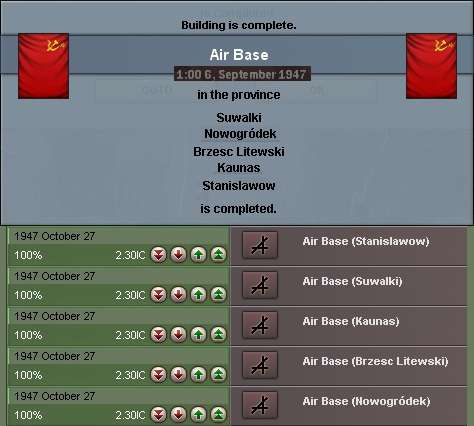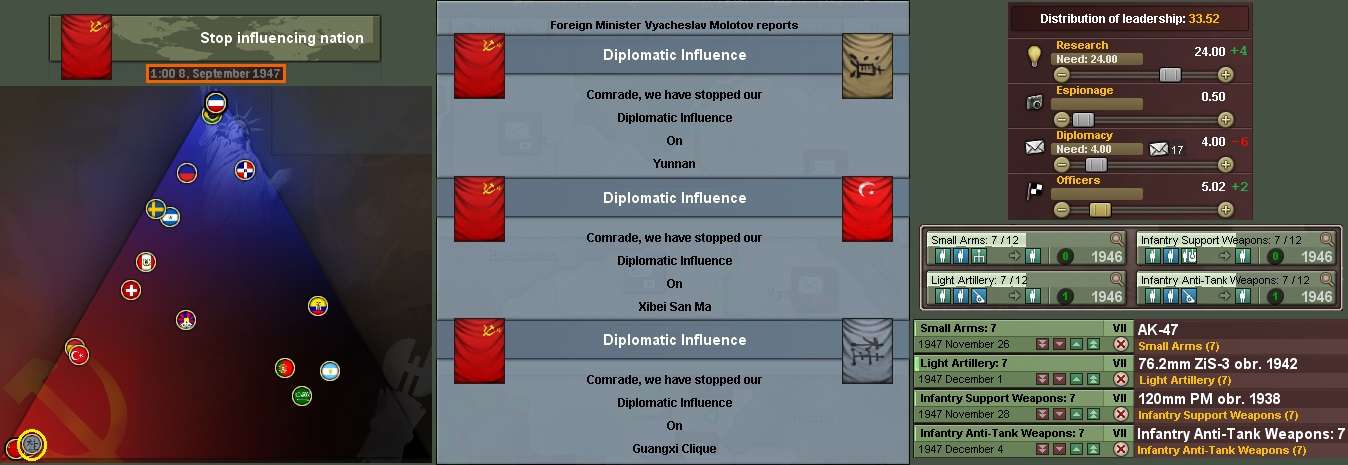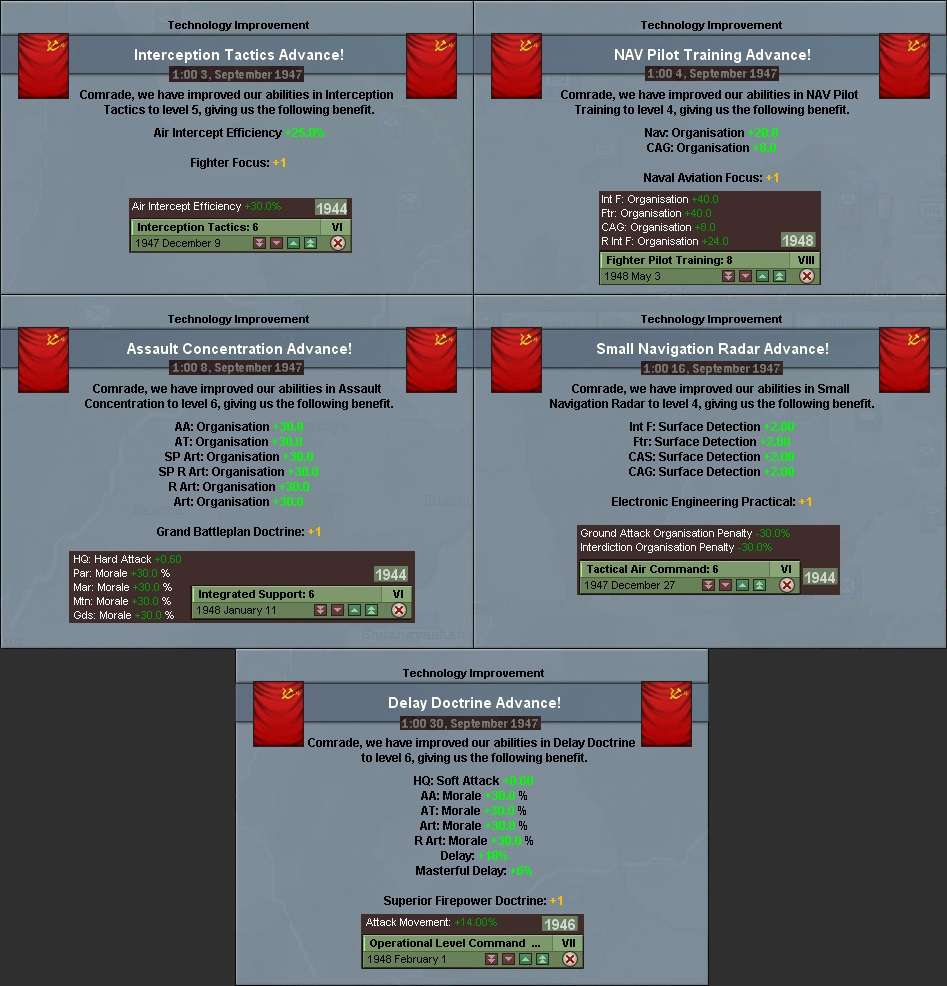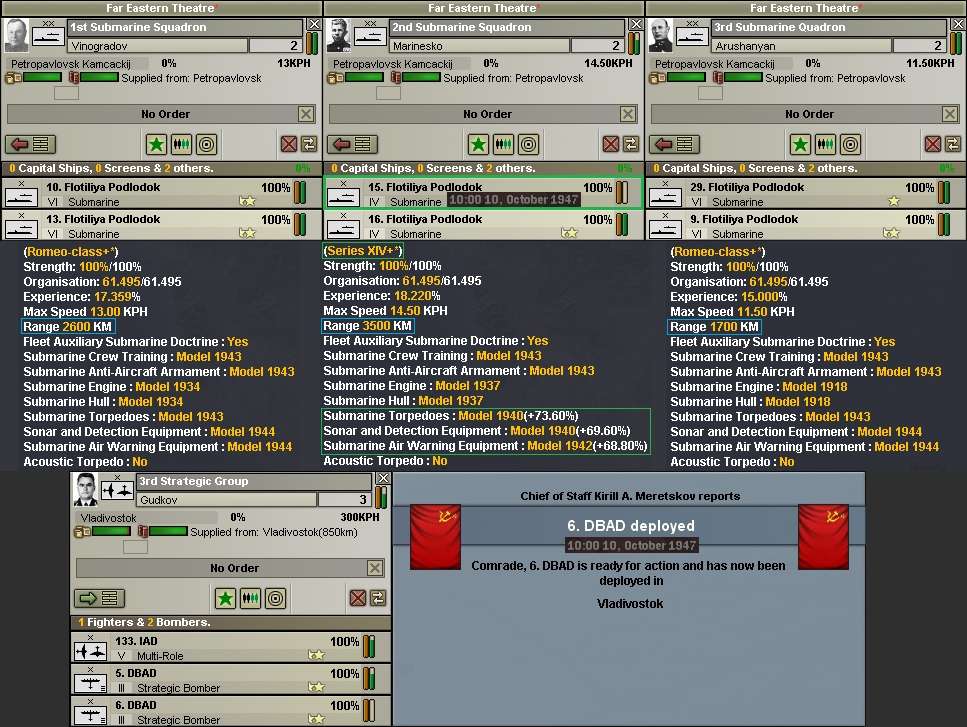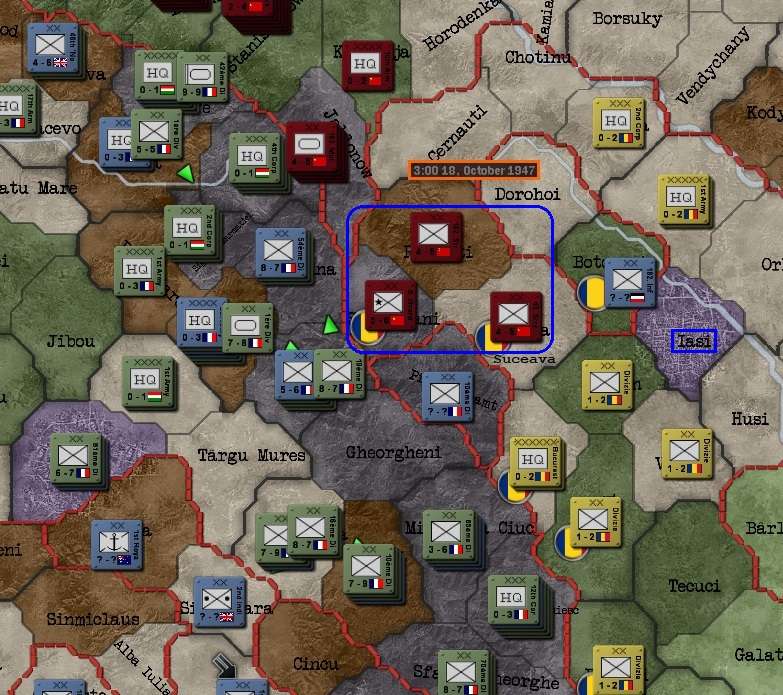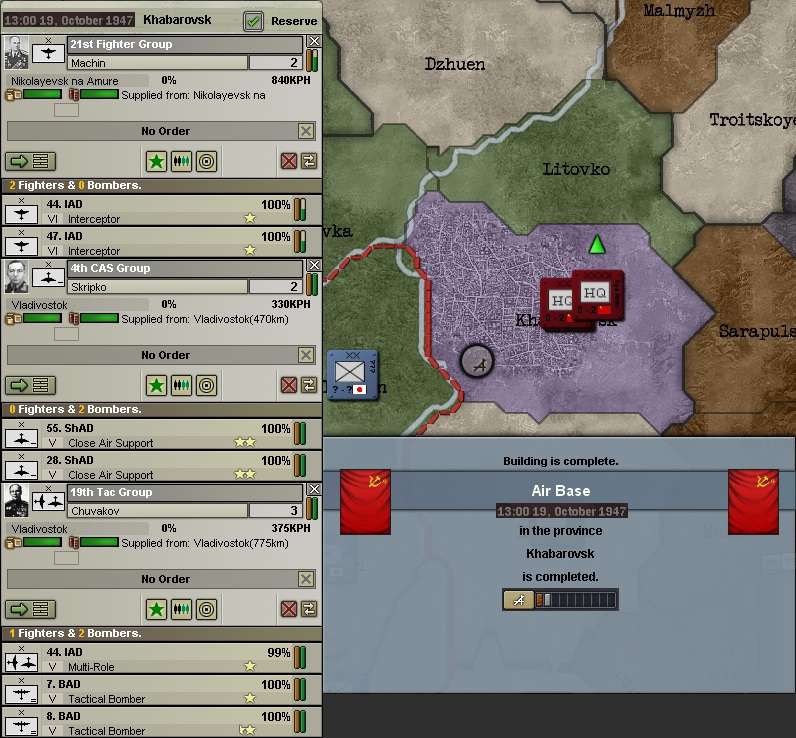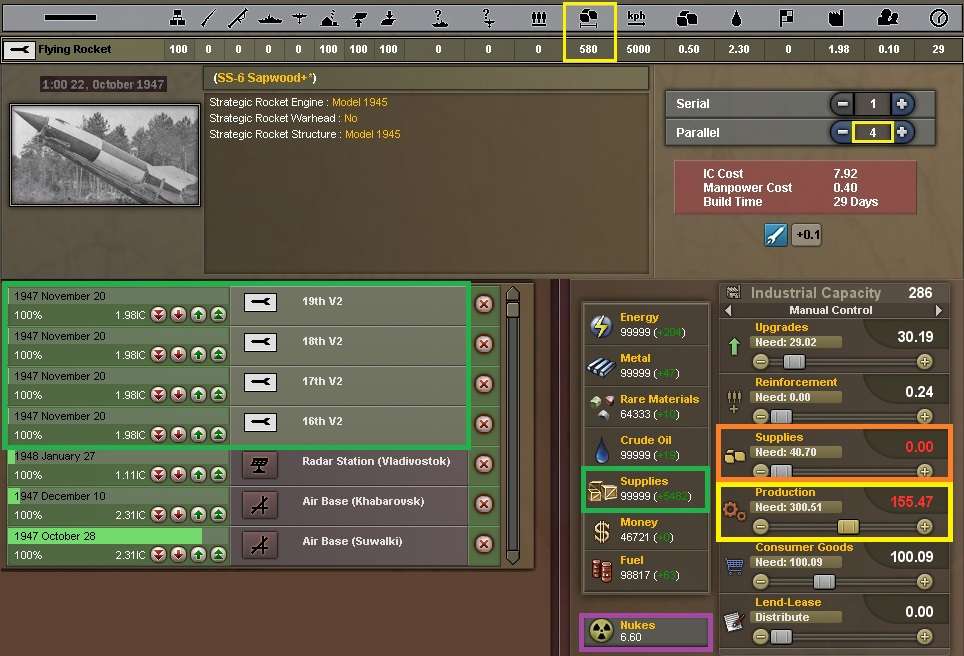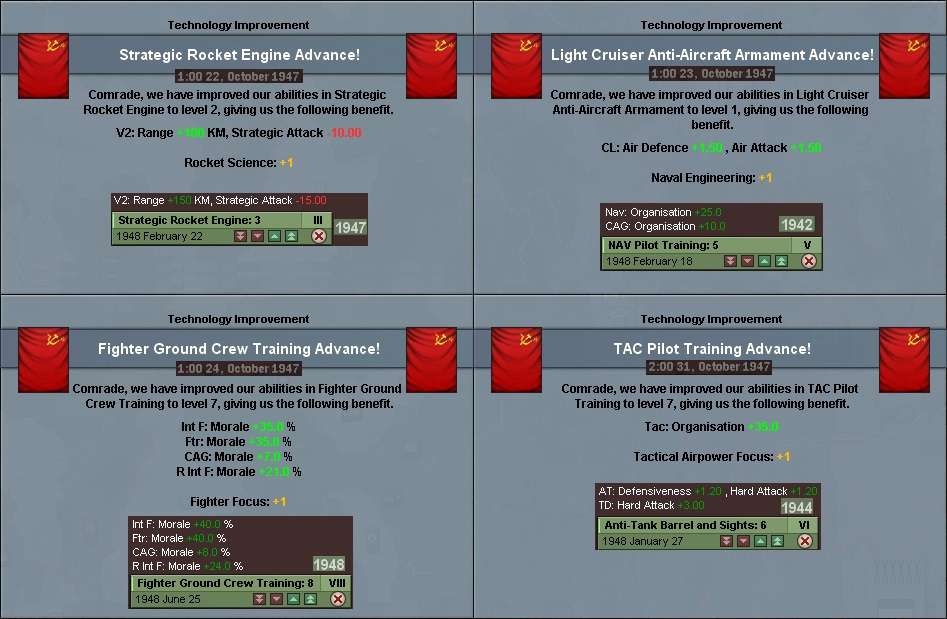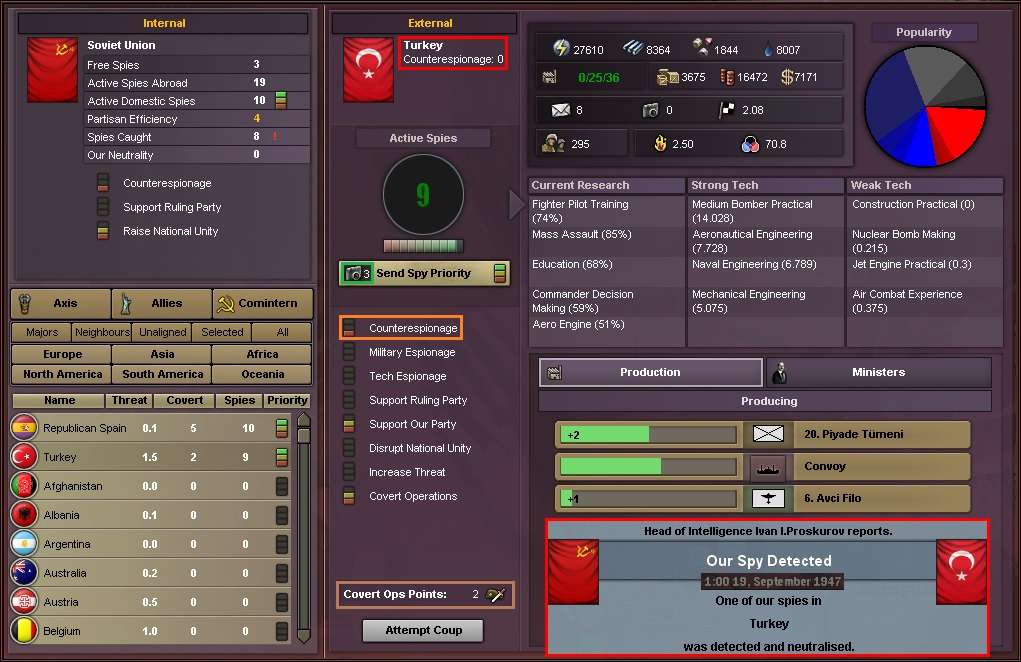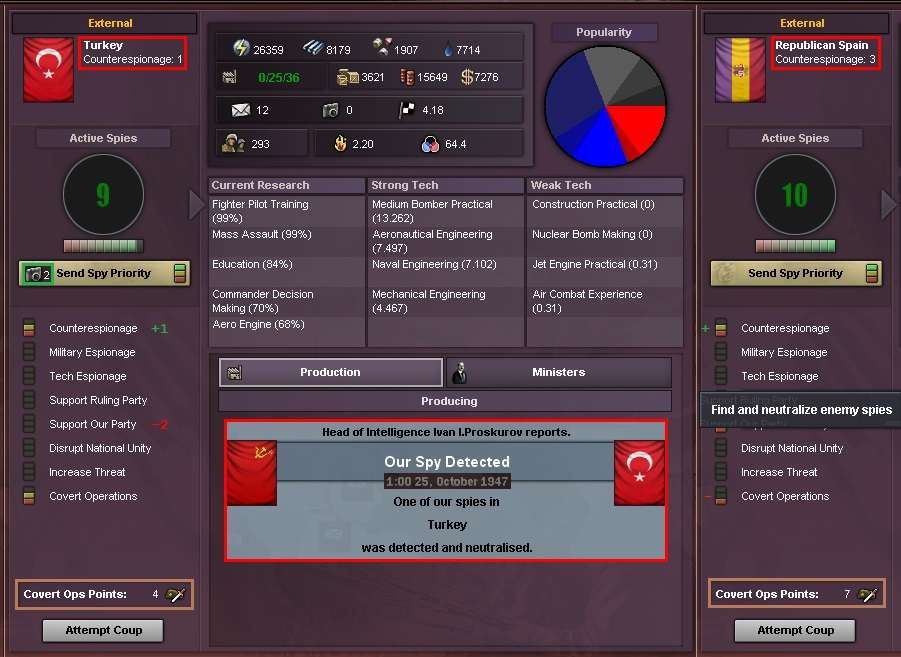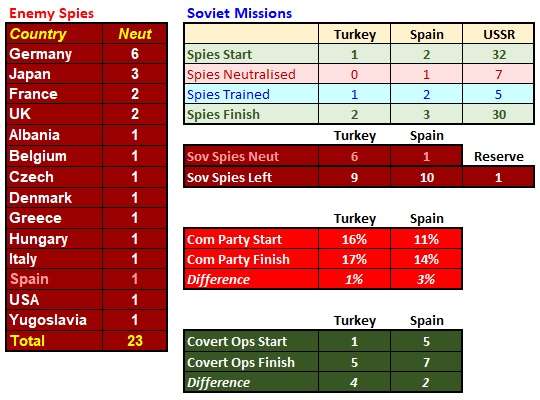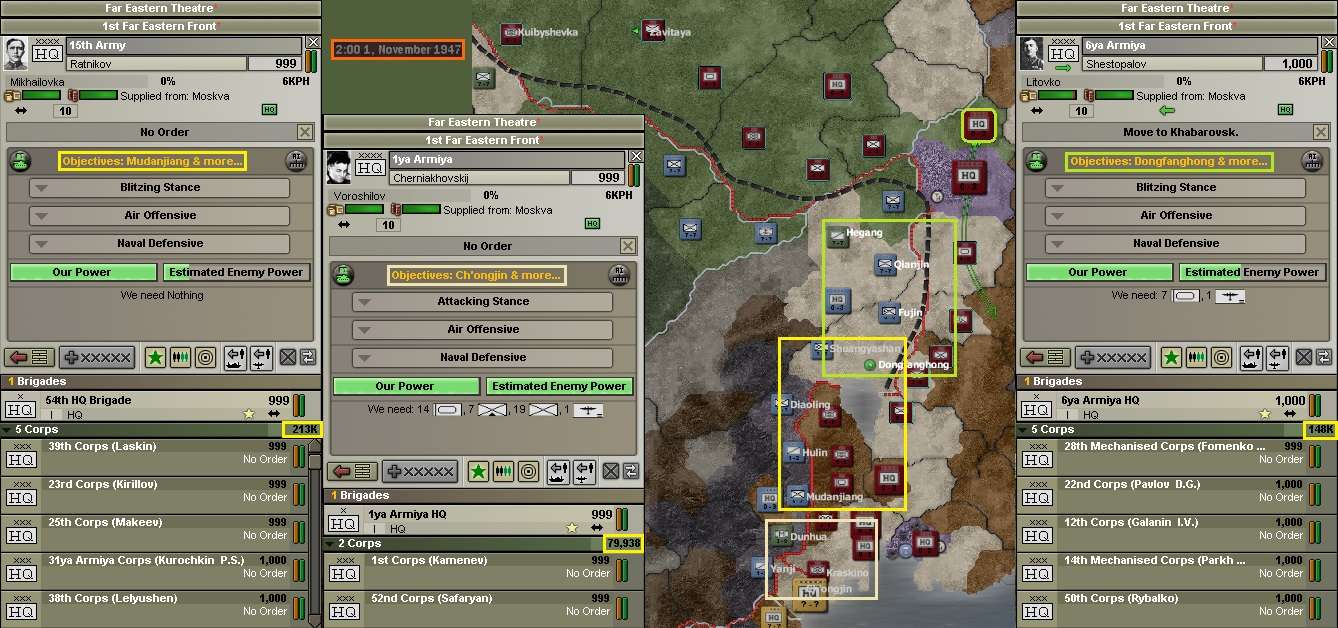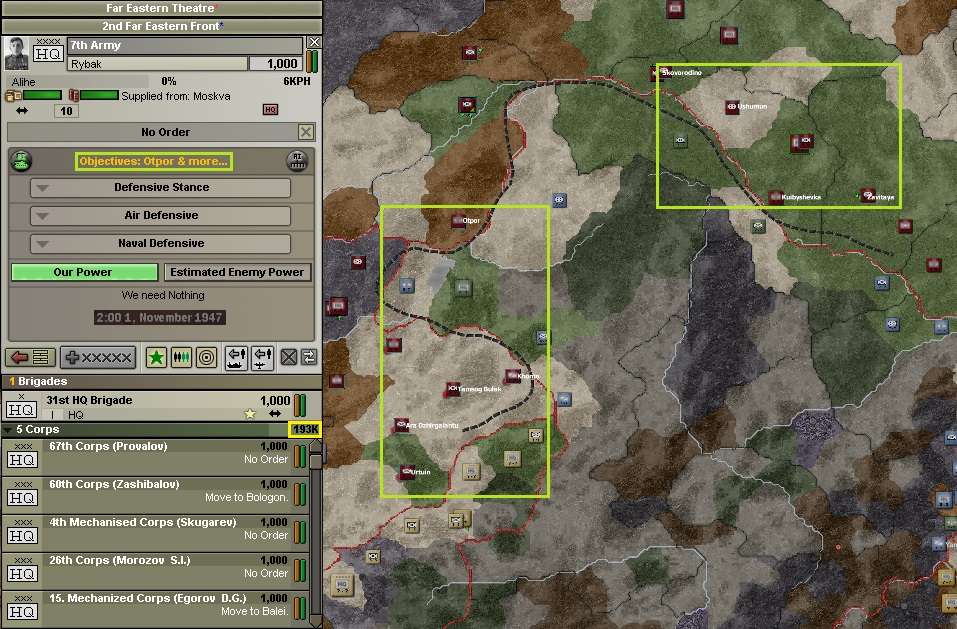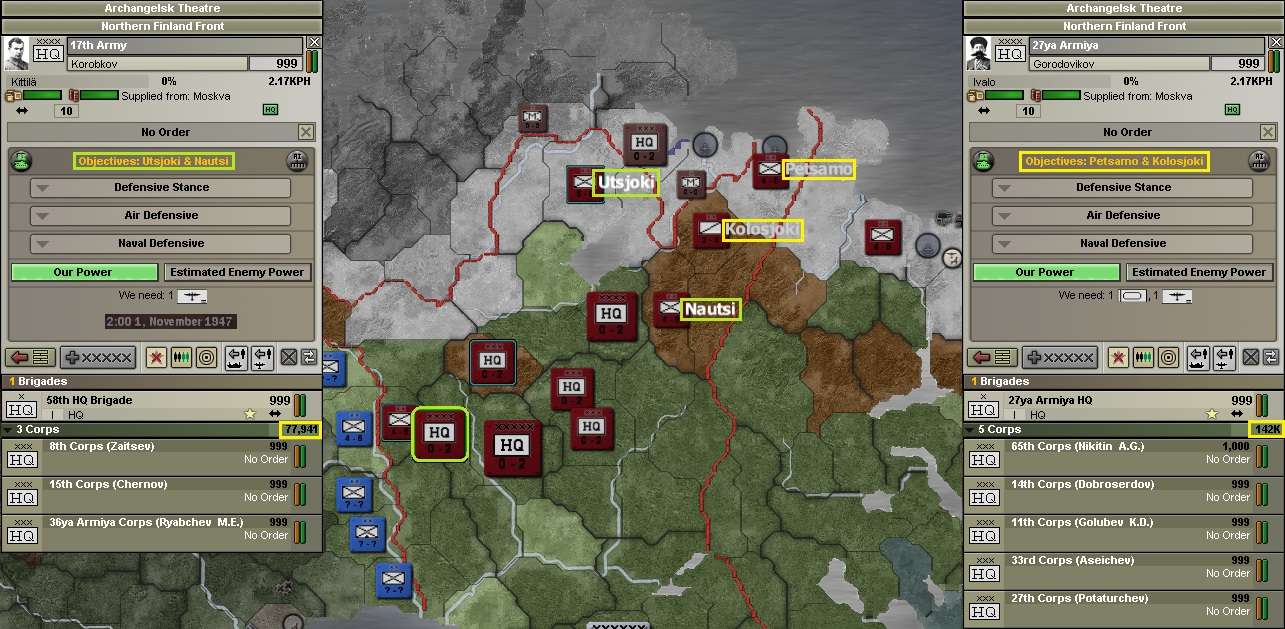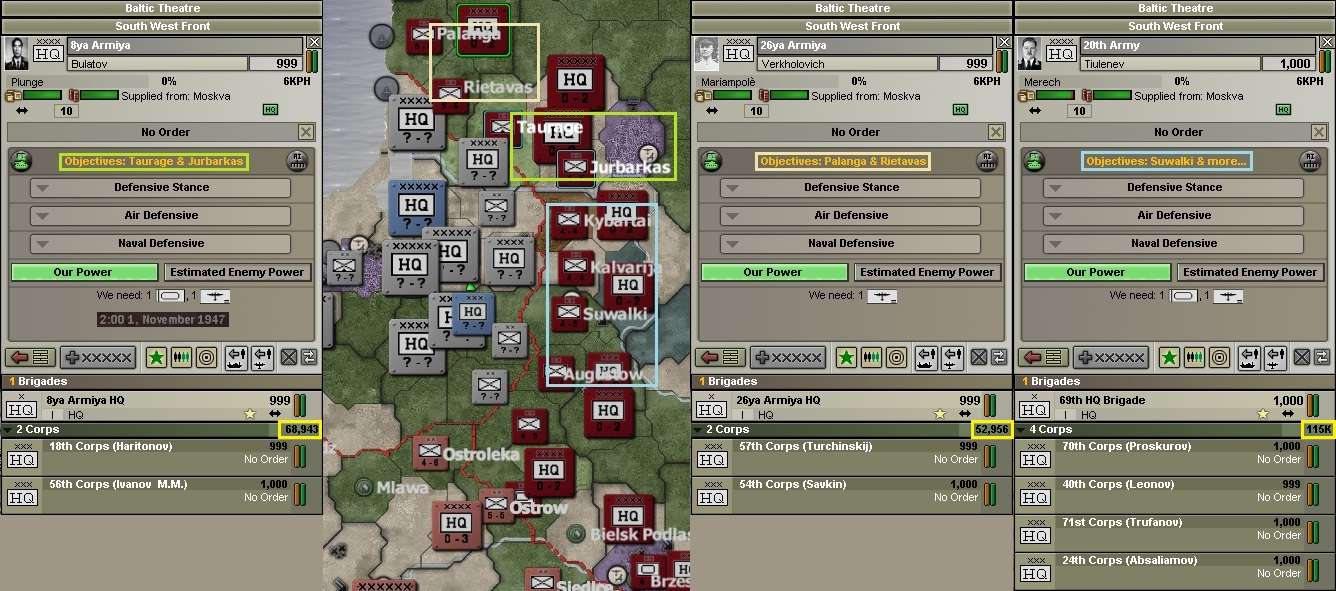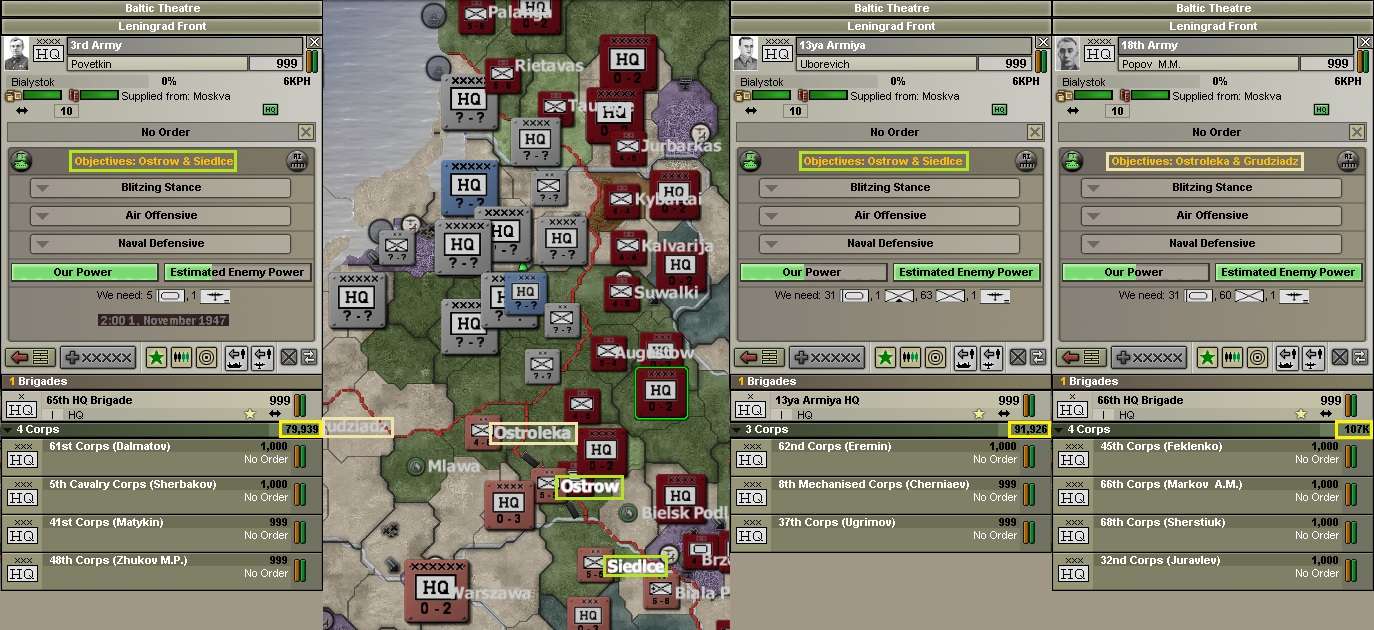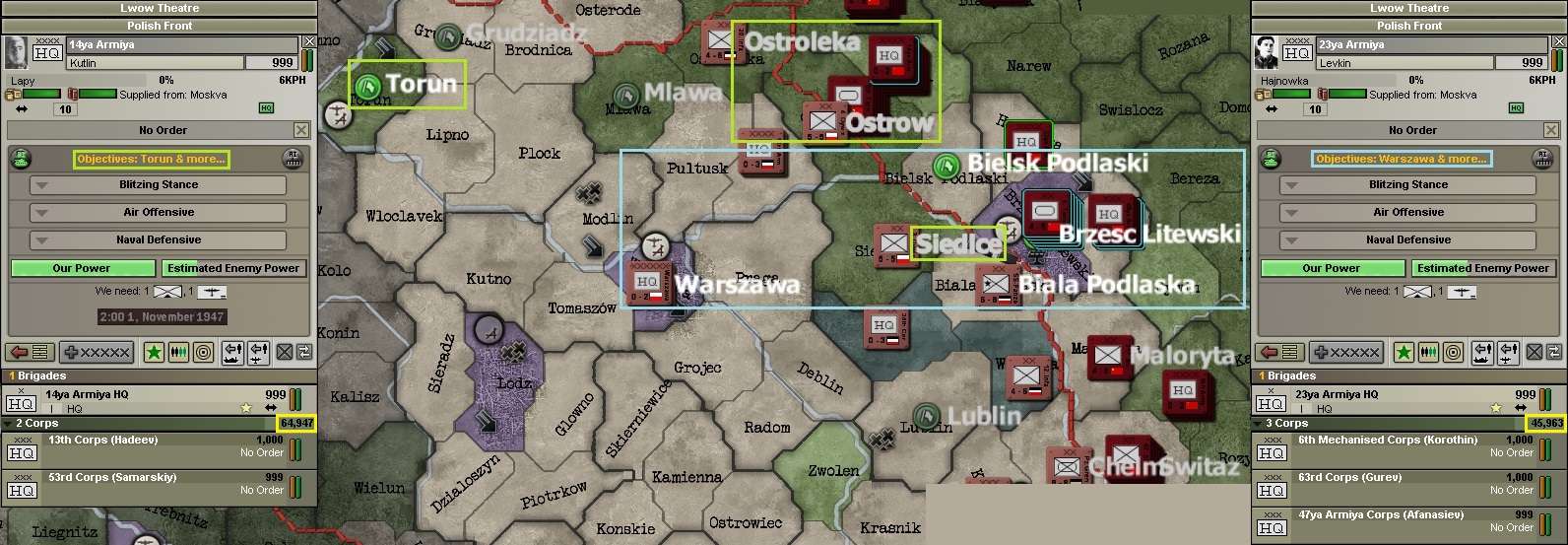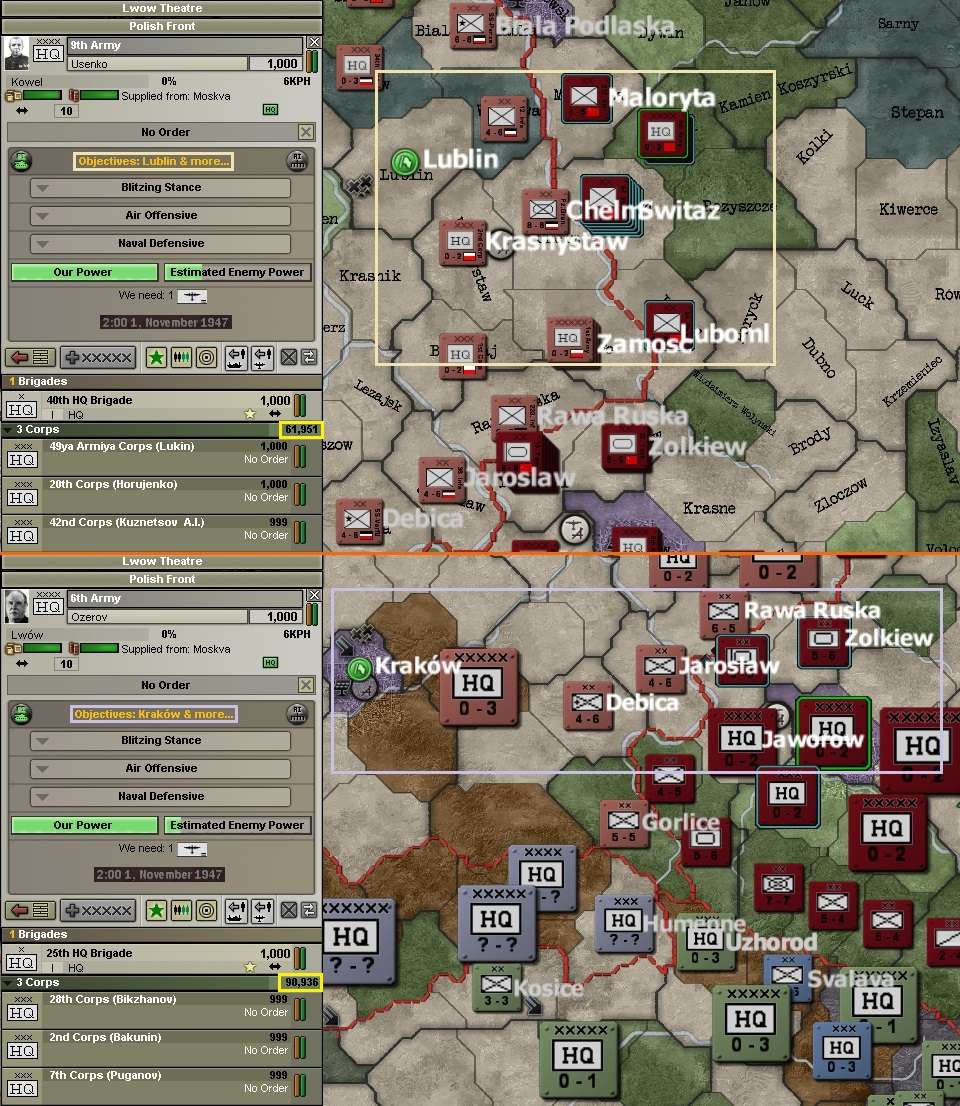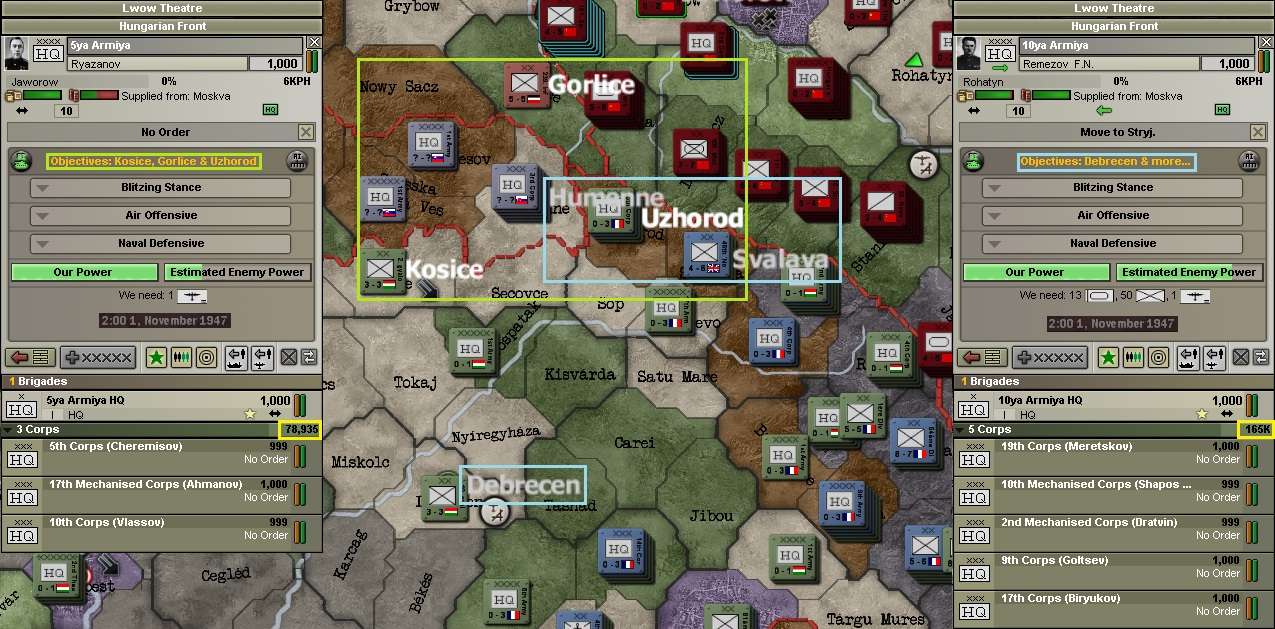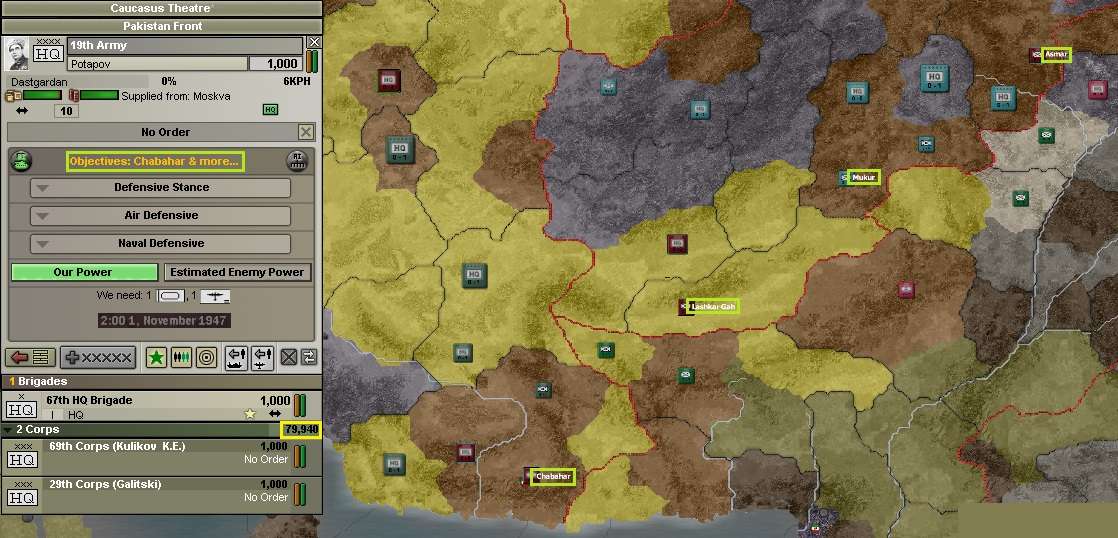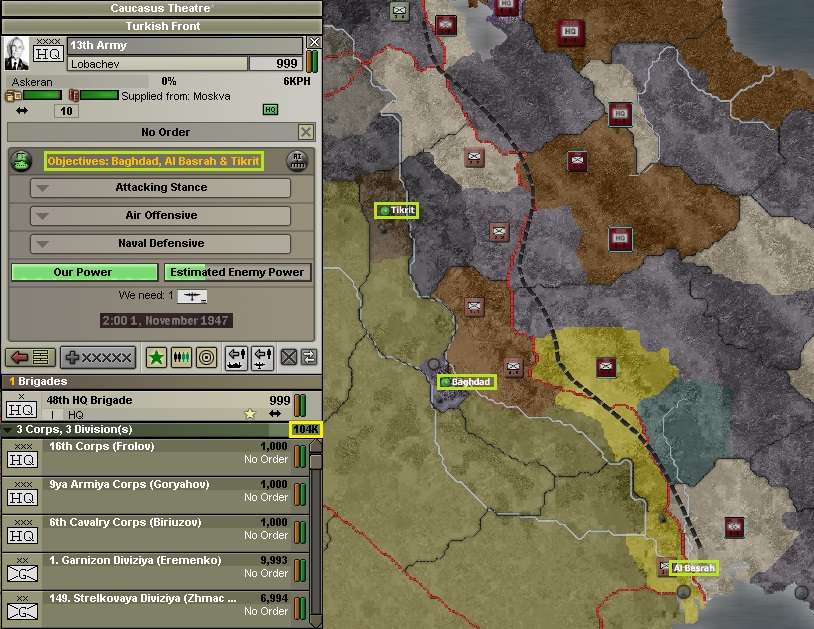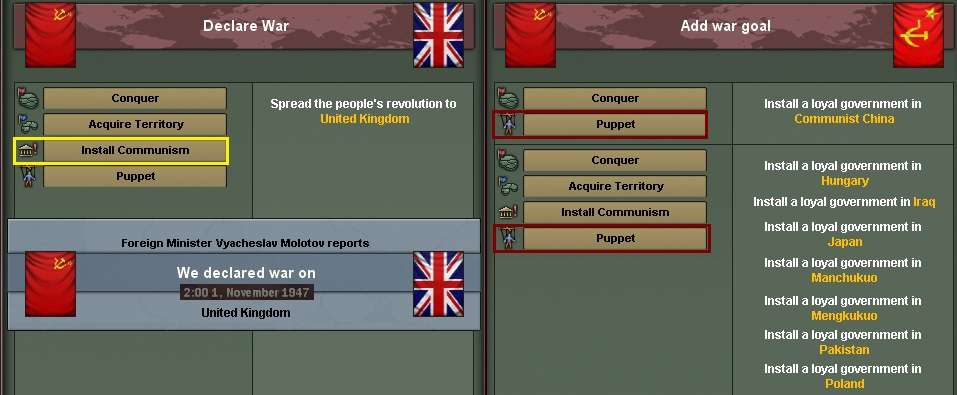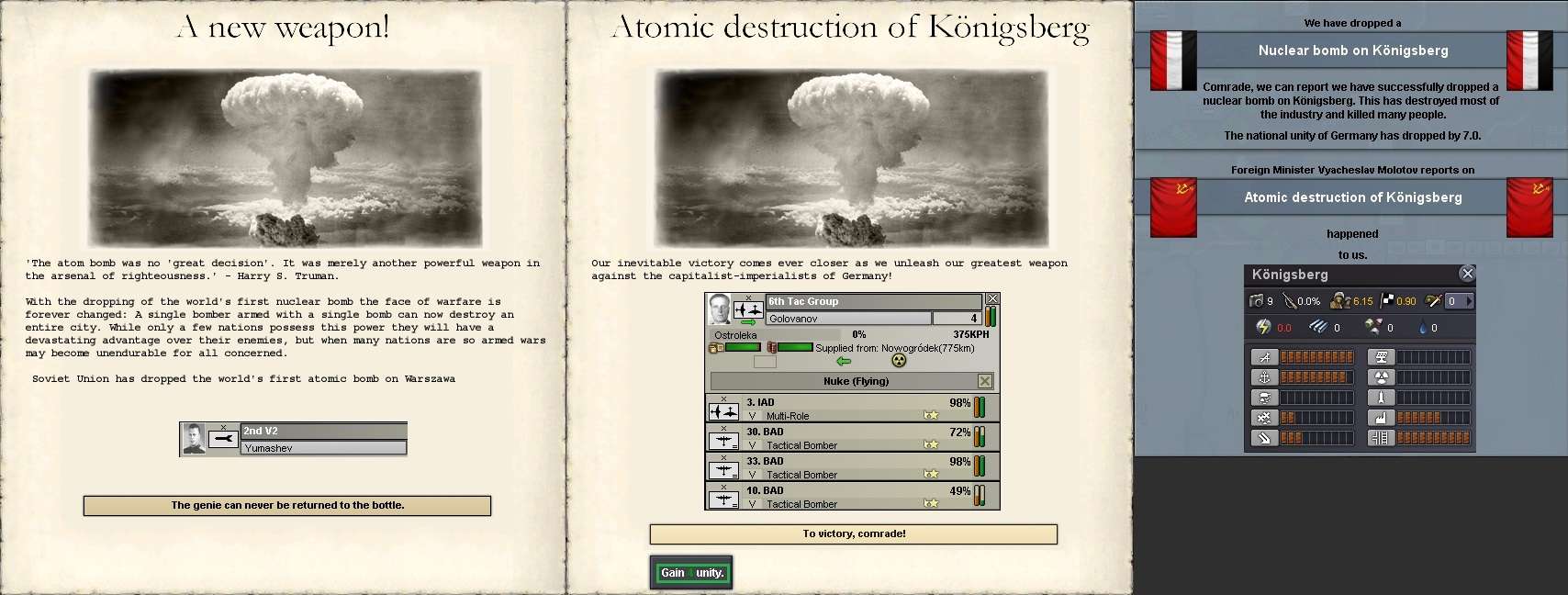I would think the long range missiles (V1/V2) would be more useful against the Japanese.
- 1
- 1
Definitely do this! Also, maybe another corps in Romania to control the chaos there?Khabarovsk itself was now very lightly held. It may be necessary for a corps to be detached and allocated under Theatre HQ (ie human) control to establish a basic screen in this area, so another cutting-off of the main armies around Vladivostok did not occur, as had happened disastrously to the Japanese in WW2.
Stalin... actually caring... about the need for Consumer Goods? Or dissent? Dose that with 9mm Makarov!
The "neutrality" shown in the diplomatic window is the effective neutrality, which is the country's base neutrality minus the largest threat against them. The tooltip explaining why you can't invite them to the faction references this invisible base neutrality value.A diplomatic assessment soon after revealed that both Xibei San Ma and Yunnan were now closely enough aligned to the Comintern to join it, if their neutrality hadn’t been too high [the calculations for which I can’t seem to reconcile with the threat figures shown].
That manpower stock is a bit concerning, given all the other usual advantages Germany has in this game. Still, most of that is likely to be lost on mobilization.An intelligence assessment of Germany (the principal initial land opponent in the west and key target to knock out of the war early) showed their rare material (0), supply (28) and fuel (6) stockpiles empty or almost so. Their manpower stood at 1,530,000, officer ration at 138% and national unity sitting on 65%.
Marshall Zhukov is a "Military Entrepreneur" in Stalin's Russia. Top work by Paradox there.At this time, Marshal Georgiy Zhukov was made Armament Minister, even as supply demand was finally almost zeroed out. Stalin should probably have done it a bit earlier, but his predecessor had been assisting jet and nuclear research. However, as those branches were now established to the Soviets’ satisfaction and supply demand was bound to escalate once war came again, Zhukov should be able to assist in that regard once mass movements were once more afoot.
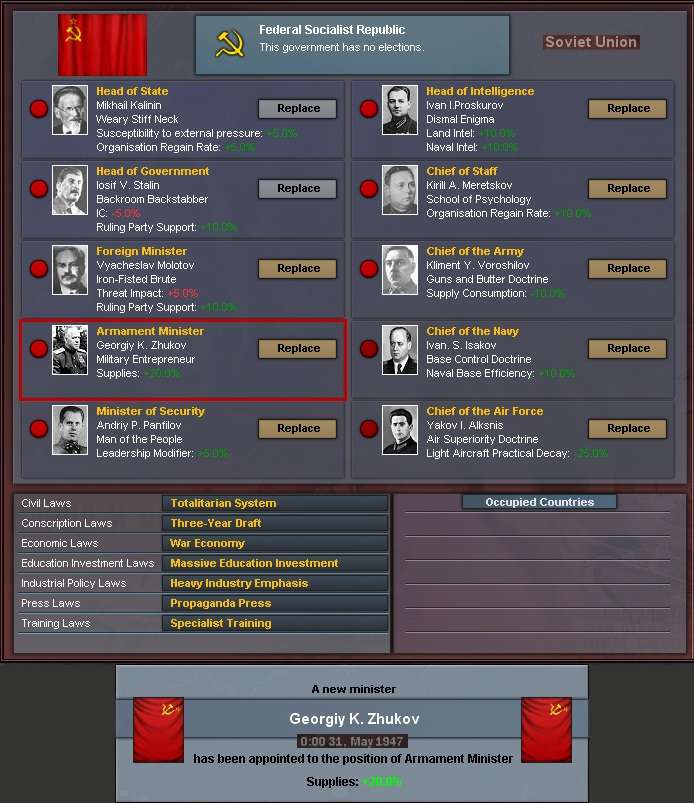
I'm unsure as I've never managed to have a successful coup, but it seems like you need about 20% party support in the target nation to attempt one, in addition to the listed cost in Covert Ops points.[Question: How much do you need before a coup attempt, for example, would have any chance of working if the covert ops points were available? I’m unfamiliar with the mechanic.]
The Gloster Meteor is famously not a jet engined aircraft as everyone at Paradox knows. Reminds me why I was so pleased to nuke Stockholm in Furious Vengeance as Paradox deserve no less. That said they've done a good job in capturing the engineering incompetence of the Germans in having such a wide variety of jet engines, none of which actually work properly or are any good.Stalin’s agents sought commonly available information on the key Allied air forces in Europe to ascertain whether they were converting to jet engines and, if so, how far they seemed to have progressed.
The Germans had switched to jet propulsion, but their conversion was patchy as yet. Some wings were fully converted, while others were at various stages. Later analysis determined this was due to industrial shortages preventing full upgrades programs. Neither the French Air force nor the RAF had begun to adopt jet propulsion as yet.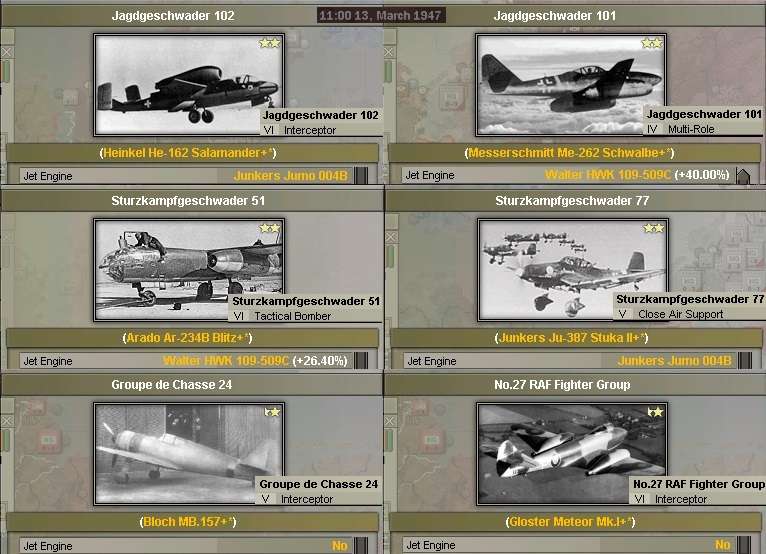
Unironically that is actually top work by Paradox. Just on that cabinet shot - MoS Panfilov is a Tank general who was never in GRU/NKVD, CoS Meretskov's main experience of 'School of psychology' is being tortured by the NVKD till he signed a confession to get his fellow generals purged, CoA Voroshilov was an utter idiot who would have been purged but they had named a tank after him (the KV series) so he was kept as a PR figurehead not allowed to control anything, Intelligence chief Proskurov is a corpse (purged by Stalin, obvs) as is CoAF Alksnis (also purged by Stalin). Picking someone who wasn't dead and could actually serve in that role, even if with the wrong skill, frankly counts as above average, which admittedly does tell you more about how low Paradox's standards are.Marshall Zhukov is a "Military Entrepreneur" in Stalin's Russia. Top work by Paradox there.
Heh, he's worried about the effect of dissent (which at low levels could be the equivalent of non-Stakhanovite enjoyment of the national pastime - of drinking copious amounts of vodka and thus taking the edge off IC. I wouldn't be so bold as to suggest he cared about the proletariat masses on a personal basis: they are, after all, just a part of the State and there to do its bidding (for the 'greater good', of course).Stalin... actually caring... about the need for Consumer Goods? Or dissent? Dose that with 9mm Makarov!
More on that next chapter. The problem in the Far East (with current dispositions) is their short range, which those typically being far closer to possible targets in the West, as it stands.I would think the long range missiles (V1/V2) would be more useful against the Japanese.
1. See next chapter1. Definitely do this! Also, maybe another corps in Romania to control the chaos there?
This month the researches have been very busy! Good job for them and allocate a dacha for each of them!
2. Among the FTR, INT and TAC techs how many are left that are not current year's?
After puppeting Germany, supporting them with some rare materials would be a good idea.
About the supply production stuff, I think it was a bit evident a lot would come back from the network so producing that much was probably unnecessary and might have resulted in some wasted IC but no big deal. We seem to be getting quite ready for the big thing!
True words, but more on that in the next chapter.That air force upgrade is a huge IC drain but will really help when total war kicks off assuming you can keep air superiority. Looking forwards to seeing how it goes.
Very much. Full-strength industry in Germany (especially) would make it even harder than it already is.It really helps that the fascists are crippled by missing rare materials.
I think the spies influencing local politics in Spain must have backed off after the final defeat of the Axis. More on political and covert missions in the next chapter.Interesting that the Spanish Communists are doing so well, let's hope it stays that way until the next election, or until you launch a coup...
The supply expenditure is through the roof. With so many supplies being sent to the far east, and back to Moscow, maybe you could target something around the 30k-50k mark, so the stockpile doesn't max out too much when the wave comes back... It's not a massive problem to have temporary supply deficits during peace-time. Of course, when you build up for war, maxing out the stockpile during that last week/month does make sense, as it does during war time, of course.
The humble 9mm round, in the domestic context, is a Consumer good in this Stalin's Russia. The shameful peace shenanigans by the capitalists clearly so enraged the Soviet People many millions of extra rounds had to be "consumed" to quell the passions of the people. Just as soon as the people realise that Comrade Stalin had a plan all along they will become more quiescent again.
Ah, thanks for explaining.The "neutrality" shown in the diplomatic window is the effective neutrality, which is the country's base neutrality minus the largest threat against them. The tooltip explaining why you can't invite them to the faction references this invisible base neutrality value.
Yes, and in this case the plan is to try to grab some VPs first (not that easy to do quickly from the east) then nuke'em till they surrender, rather than wearing down their MP. Will see how that works (or not) when the time comes).That manpower stock is a bit concerning, given all the other usual advantages Germany has in this game. Still, most of that is likely to be lost on mobilization.
Marshall Zhukov is a "Military Entrepreneur" in Stalin's Russia. Top work by Paradox there.
Right, thanks again. Will see if I can ever get to that magical theoretical launching point!I'm unsure as I've never managed to have a successful coup, but it seems like you need about 20% party support in the target nation to attempt one, in addition to the listed cost in Covert Ops points.
This is the calculation I've been going off too. Next chapter will show what transpires.So, if Stalin orders mobilization right away on June 1st, we can be just about fully reinforced by 22 June I think, which is a perfect time to launch an invasion, kicking down the door and all that, nothing can possibly go wrong. Looking forward to kicking off the man show at long last - Quick and Dirty, they said, and yet still I wait...
It's funny (both humorous and peculiar) how the build files don't discern between jet and prop types at this transition point. For the major powers, I'd have thought some either/or triggers could have been done, though I haven't examined the code in that area to see if its possible. Woulda been 'too much trouble', no doubt, even if possible.The Gloster Meteor is famously not a jet engined aircraft as everyone at Paradox knows. Reminds me why I was so pleased to nuke Stockholm in Furious Vengeance as Paradox deserve no less. That said they've done a good job in capturing the engineering incompetence of the Germans in having such a wide variety of jet engines, none of which actually work properly or are any good.
Ah, the world of Cabinets with zombies, idiots etc etc. At least with the Soviets there don't seem to be a lot of poets occupying slots because they were the only names they could turn up in a Google search ...Unironically that is actually top work by Paradox. Just on that cabinet shot - MoS Panfilov is a Tank general who was never in GRU/NKVD, CoS Meretskov's main experience of 'School of psychology' is being tortured by the NVKD till he signed a confession to get his fellow generals purged, CoA Voroshilov was an utter idiot who would have been purged but they had named a tank after him (the KV series) so he was kept as a PR figurehead not allowed to control anything, Intelligence chief Proskurov is a corpse (purged by Stalin, obvs) as is CoAF Alksnis (also purged by Stalin). Picking someone who wasn't dead and could actually serve in that role, even if with the wrong skill, frankly counts as above average, which admittedly does tell you more about how low Paradox's standards are.
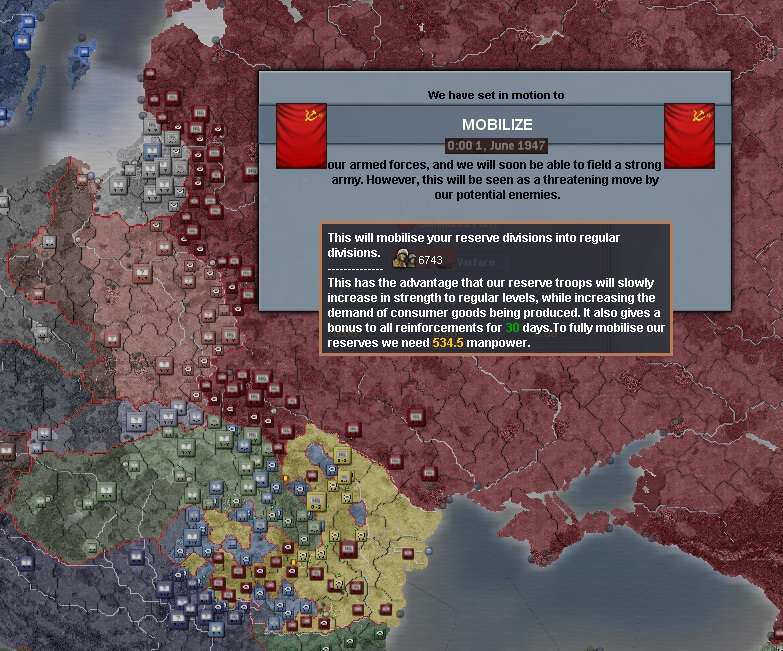
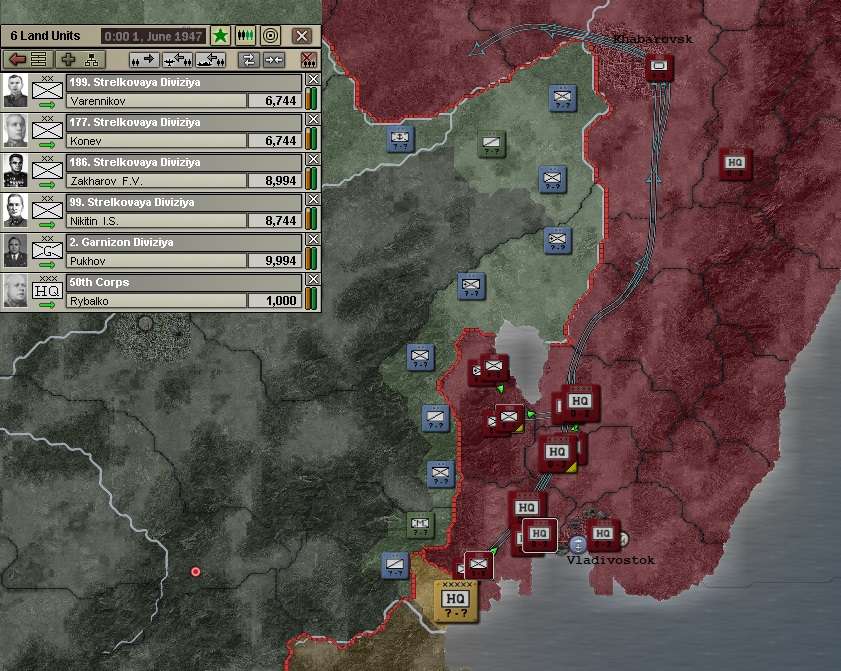
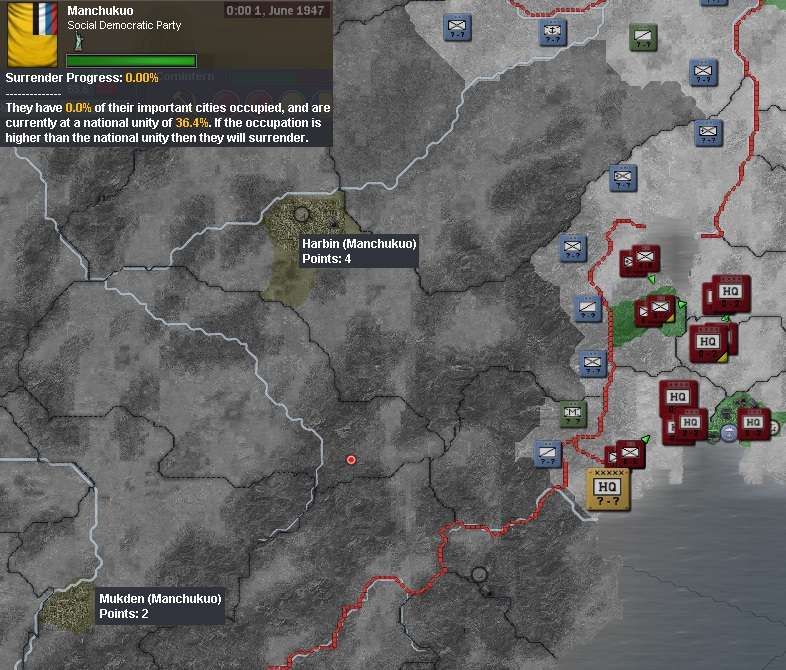
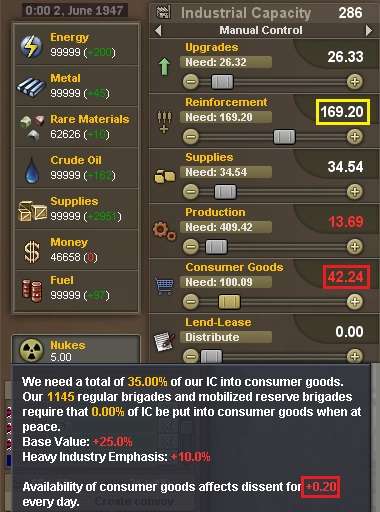

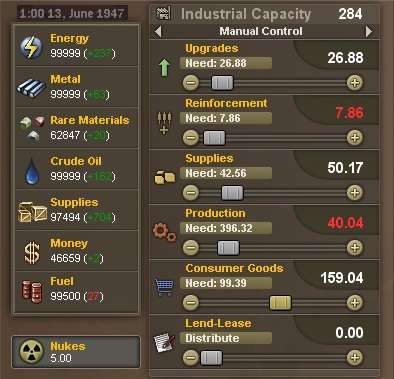
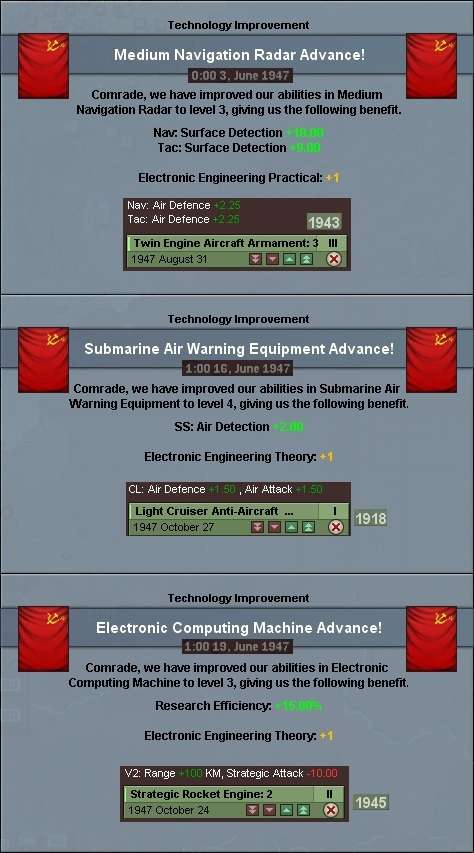


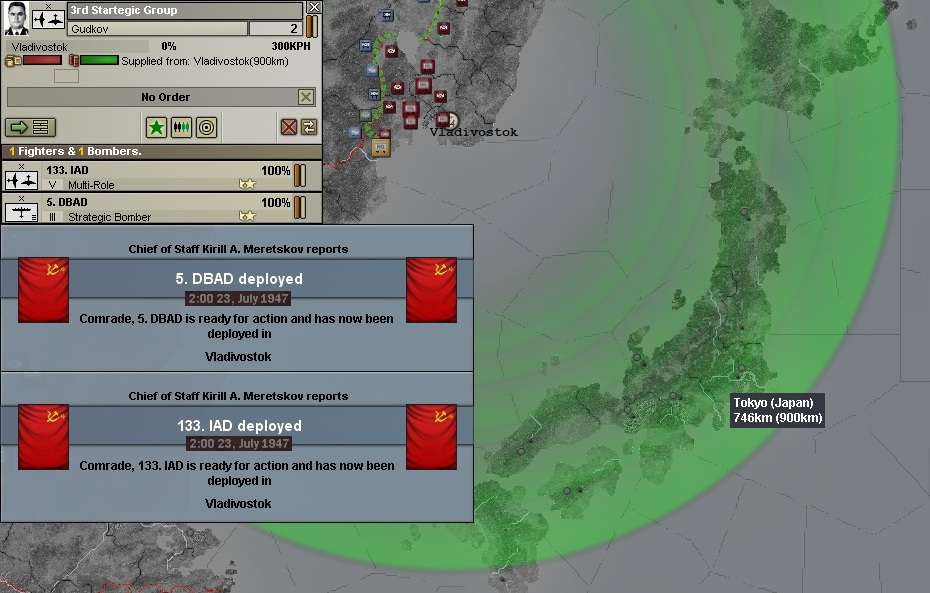
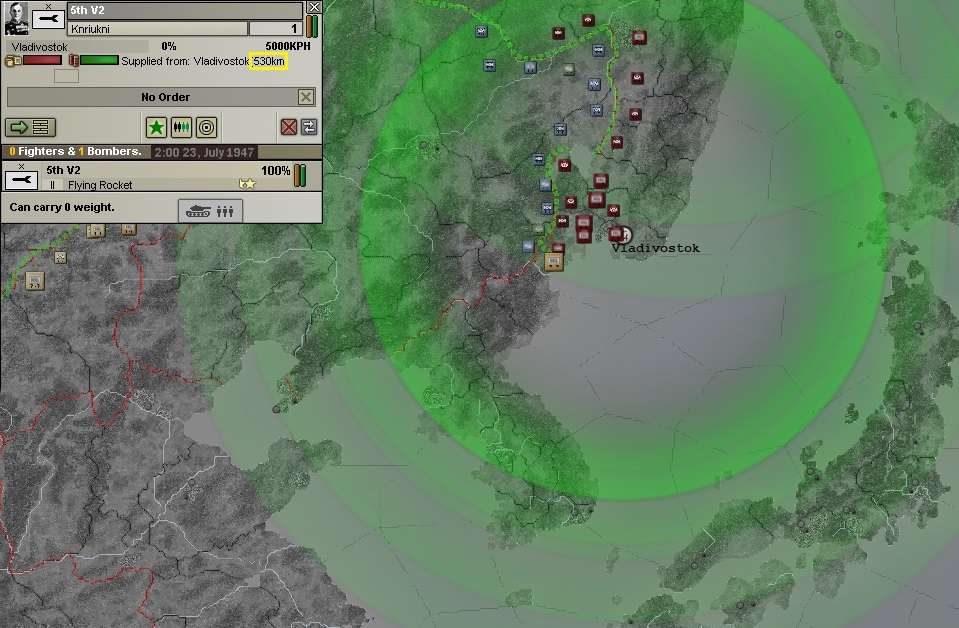
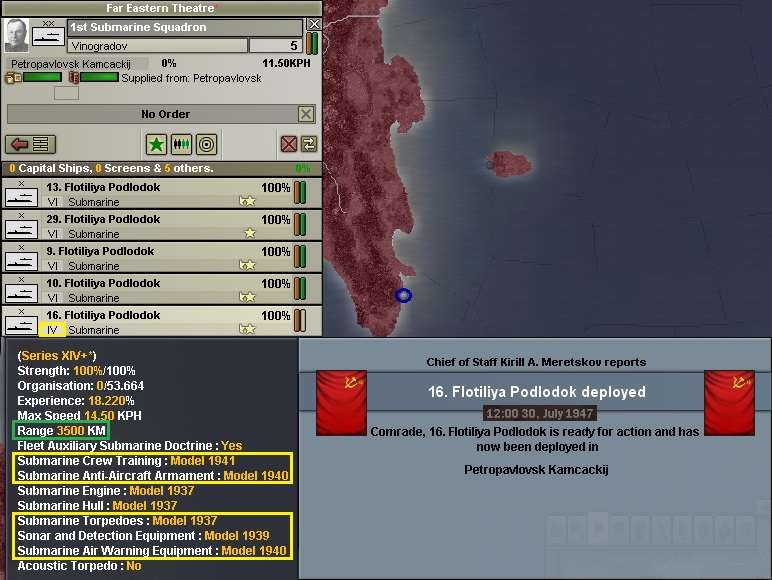
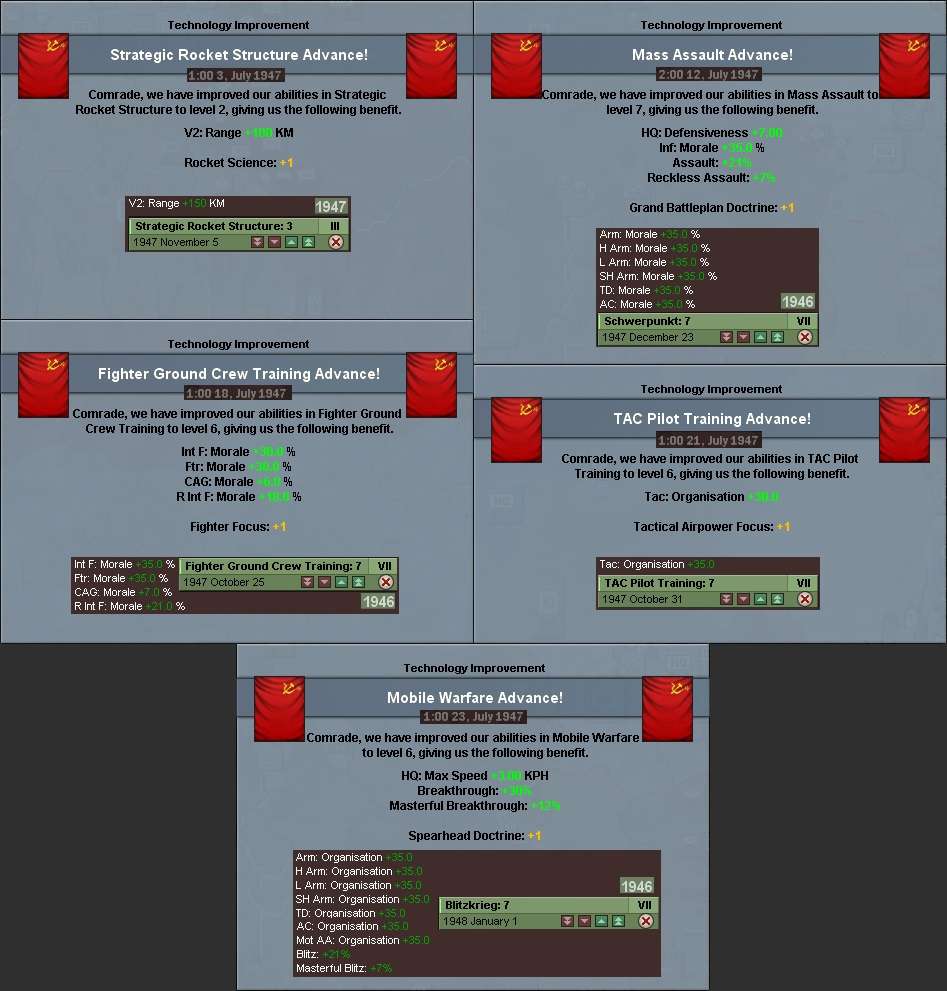
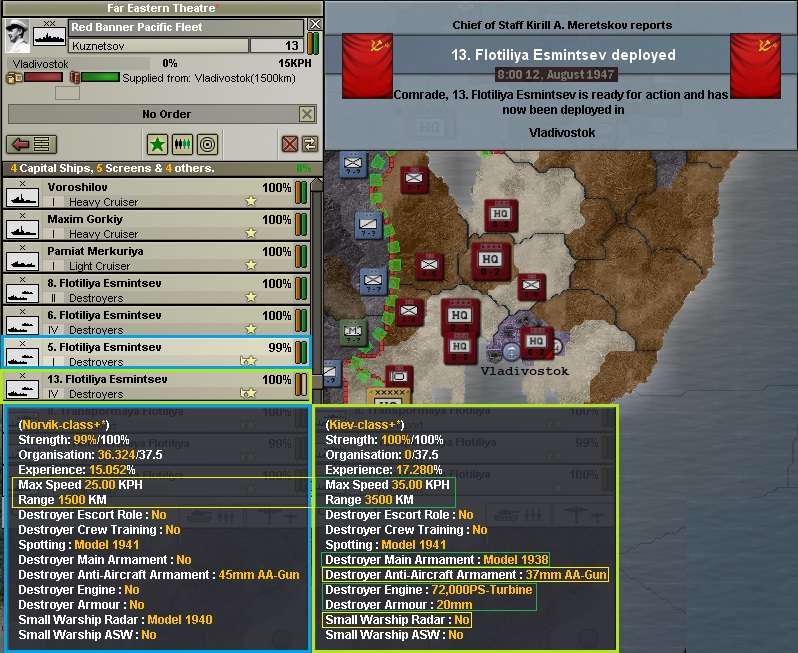
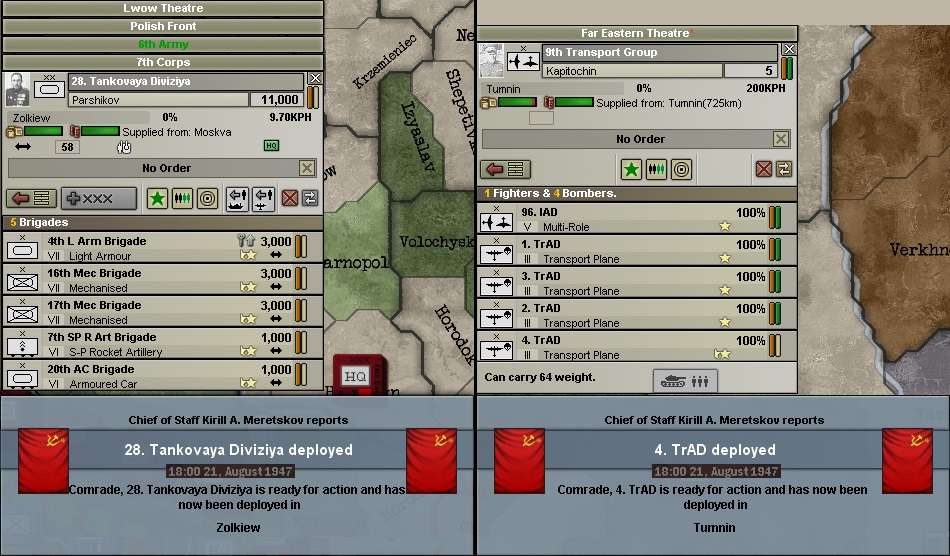

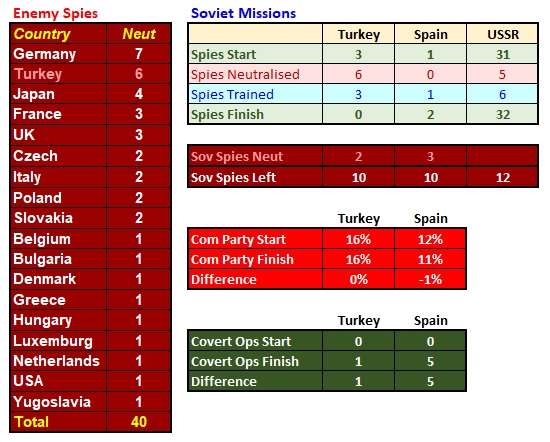
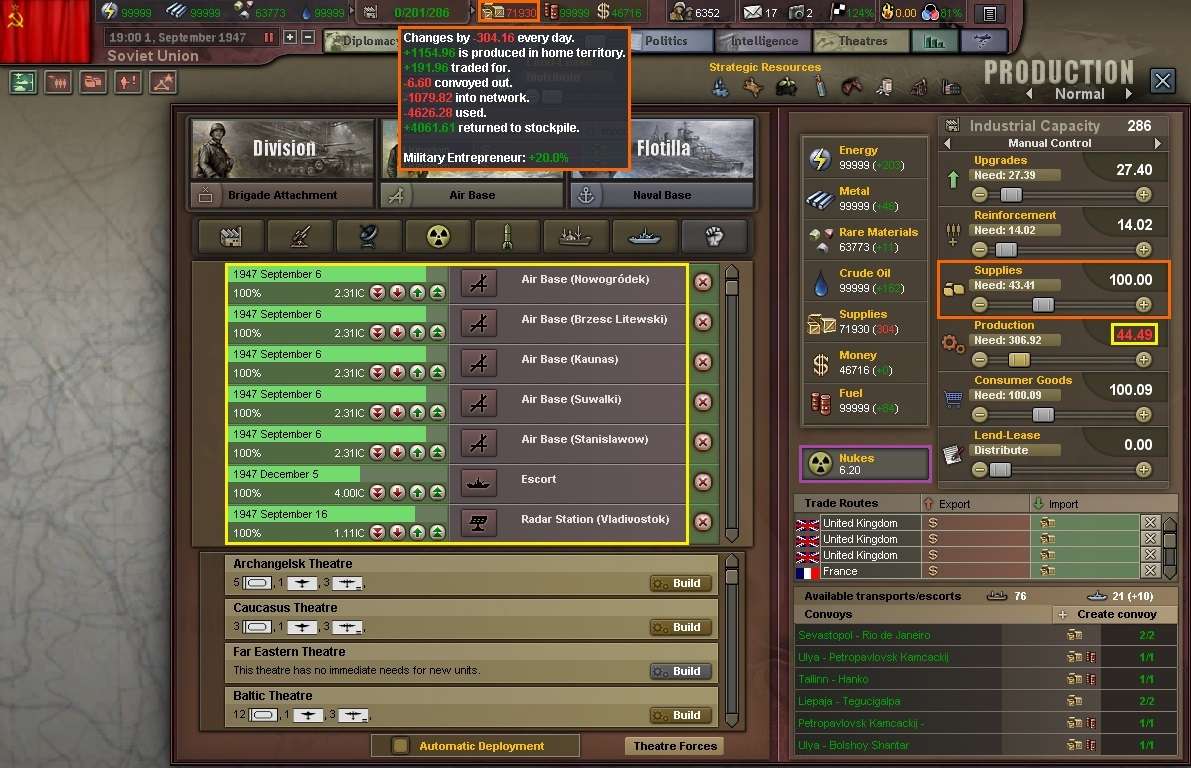
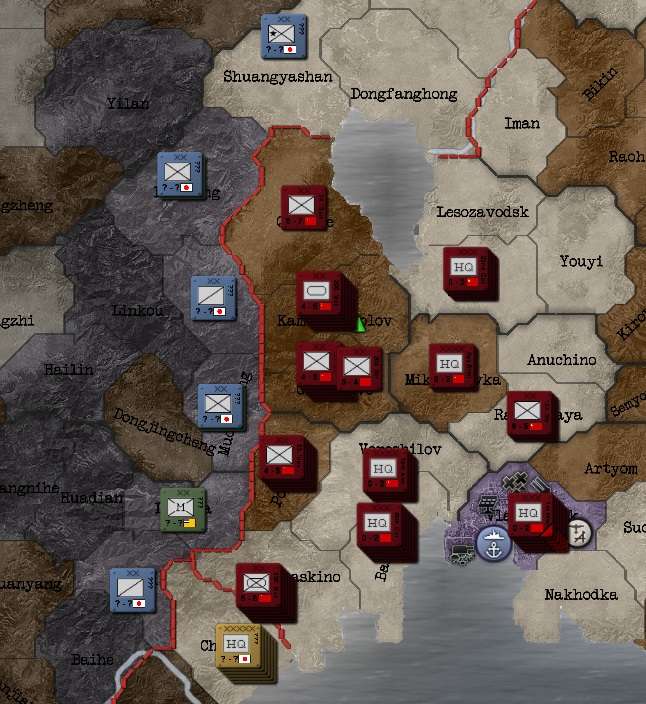
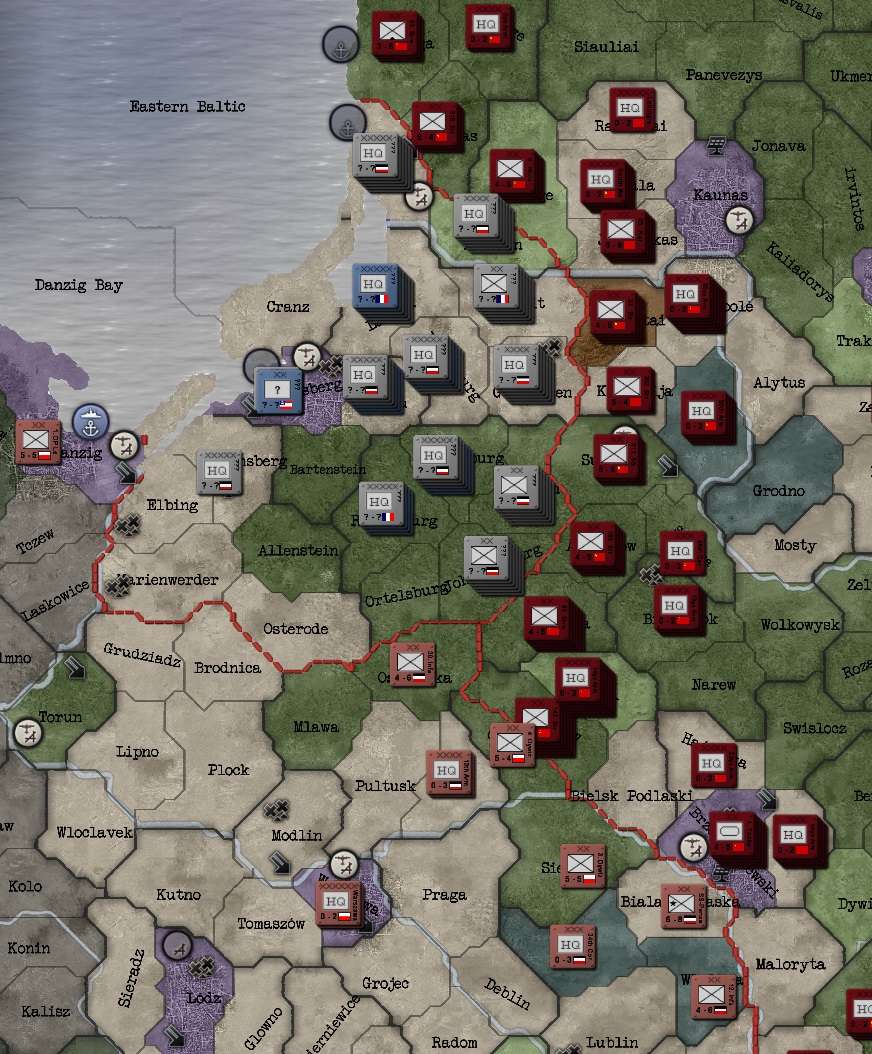
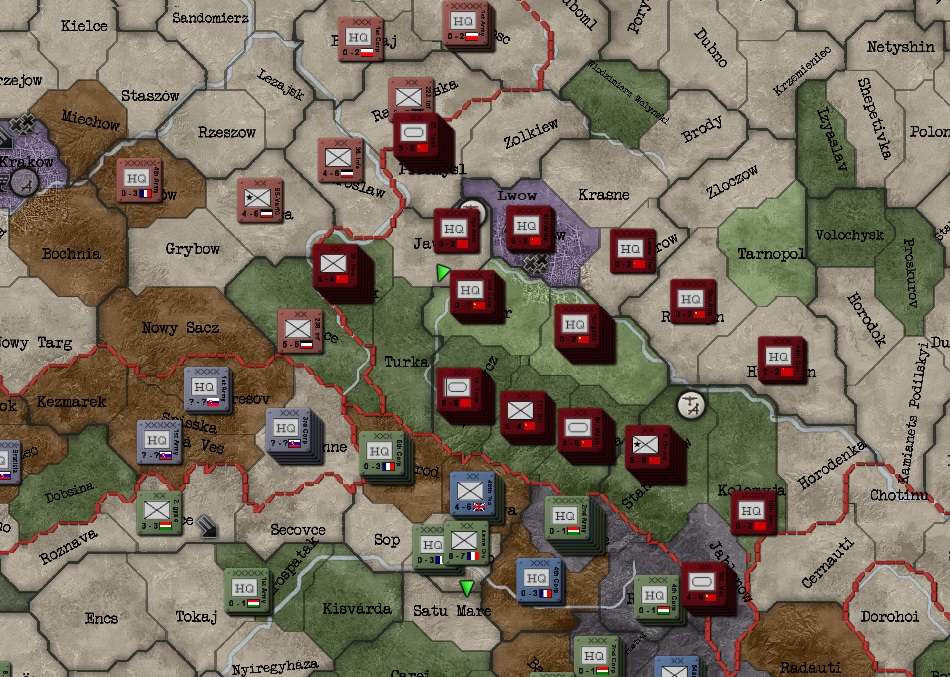
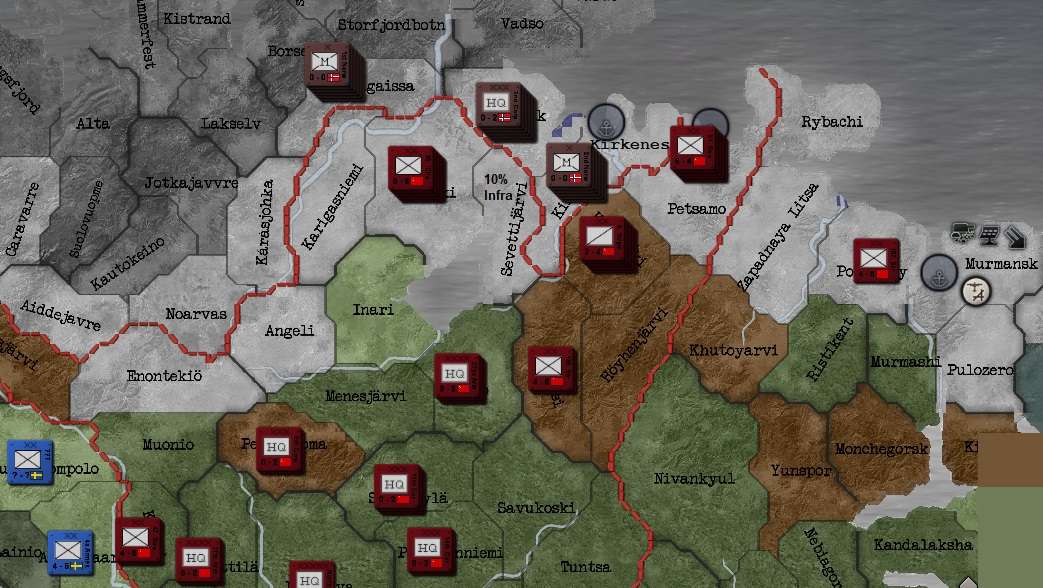
oh this has been really unluckySpoiler: A Storm of Imperfection
Seems like we're filling in the secret techs one by oneAir to air missiles (which would be a big bonus when fully equipped) were introduced for the fighter wings and the research team switched their efforts to developing acoustic torpedoes for the submarine arm.
Getting close again now, after a false start. I think it was the mechanics of about 60 Allied countries going through the DoW process! I hadn’t moved anything yet - unless it was the added complication of the AIthen reacting to the start of the war as well.So it begins. World War Three.
Yes, the sheer number of units produced by a human-run Soviet union can be quite the burden on older computer hardware... Glad to hear, you managed to get through the DOW eventually without losing the game file.
This one seemed a logical path given our side-project of building up the submarine arm. If we can’t have nuclear attack subs, then this seems the next best betSeems like we're filling in the secret techs one by one
Yes, it approaches. Part of me wanted to push forward, but I need to keep the chapters to a reasonable length.We're getting ready for real this time, it's really exciting! I wonder how it will go, the debacle with the failed military exercises should've taught a lot to Soviet commanders and planners
Stalinist revisionism at it's finest. "There was no war comrade, you were imagining it."And even after about a week of combat, some fronts on blitz with light opposition had not launched an attack, while other on defensive were making bloody attacks in East Prussia. The Air Force was quickly rendered useless, many of the wings never even getting into combat, while the Luftwaffe pulverised several provinces. There were still some reasonable air battles, but the lack of several groups of interceptors due to the initial relocations was decisive. Even the Hungarian, Polish and Greek bombers were often striking at will.
Also, it became clear that the way the objectives were interpreted by the AI in the Far East had scrambled their layout, separated the Army HQs from the bulk of their troops and concentrated them strangely in large pockets and left Mongolia wide open. The whole thing was a dogs breakfast. I also realised I’d need to take a more general and different approach to recording progress on the battlefield and recording all the battle and air raids details as I had for the Far East was going to be unworkable for a supposedly ‘quick and dirty’ AAR.
Purges, excellent, the Soviet way remains as it always has. It is good to know that some still keep to the old ways.After a series of purges, demotions and ‘re-education’, he Soviet Union went about refining its plans, dispositions and waited for the badly disorganised air wings in the West to reorganise – a time-consuming process.
In another ATL, the Turkish intelligence services wonder why all of these "Japanese" agents look awfully Russian in complexion.That day, a Turkish spy was neutralised, then another on the 27th, but at the cost of a Soviet spy lost there on the 28th in a bloody escalation of the Secret War.
Took me a bit to work this one out, largely because Paradox misspelled Novik to the surprise of none present I am sure. At least it did exist, though interestingly the reference as "Novik class" seems idiosyncratic depending on which language sources one consults - English sources seem to consider each sub-class a distinct class while Russian sources seem to use the overarching term freely. A curious little fact to enlighten your day, I suppose.On the 12th, a new DD flotilla was deployed to the Red Banner Pacific Fleet. It was at least superior to the old Norvik class destroyers, some of which still served, even if they remained far behind their counterparts in the main Allied navies.
The solution of course is for this one to become slower than real time. 'Odin' is already basically so, thus Q&D2 may as well take the plunge. What, after all, is in a name?It is at least reassuring that you remember this is supposed to be Quick and Dirty. We don't need two massively detailed Soviet AARs going at once, how on earth would anyone find the time to keep up?
Let's hope so! Whether I choose wisely ... or poorly.This should be innerstin.
Quite so. Either that or (for the old hands) like that whole season of Dallas that was just a dream sequence.Stalinist revisionism at it's finest. "There was no war comrade, you were imagining it."
Massively detailed on this one would break me, let alone the dear readAARs! Q&D it must be (well, by my standards anyway)It is at least reassuring that you remember this is supposed to be Quick and Dirty. We don't need two massively detailed Soviet AARs going at once, how on earth would anyone find the time to keep up?
Quite - tradition!Purges, excellent, the Soviet way remains as it always has. It is good to know that some still keep to the old ways.
In another ATL, the Turkish intelligence services wonder why all of these "Japanese" agents look awfully Russian in complexion.
Another Paradoxian situation.Took me a bit to work this one out, largely because Paradox misspelled Novik to the surprise of none present I am sure. At least it did exist, though interestingly the reference as "Novik class" seems idiosyncratic depending on which language sources one consults - English sources seem to consider each sub-class a distinct class while Russian sources seem to use the overarching term freely. A curious little fact to enlighten your day, I suppose.
No, no - I have to get one of these AARs finished, and Q&D1 is the only one I've finished in the last four-and-a-half years!The solution of course is for this one to become slower than real time. 'Odin' is already basically so, thus Q&D2 may as well take the plunge. What, after all, is in a name?
The Makarov solution. Should be all OK from here: next throw of the dice will not be recalled, whether things work or not.See - such shenanigans is why the State must devote considerable resources to maintain the 9mm consumer good stockpiles!
Seriously though, glad you were able to get it all sorted.
